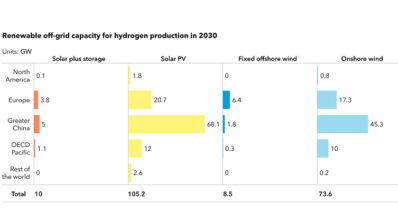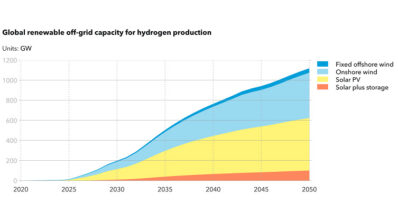Are offshore energy islands the future of hydrogen and e-fuel production?
By EPR Magazine Editorial September 2, 2022 4:44 pm IST
By EPR Magazine Editorial September 2, 2022 4:44 pm IST

Cost reductions in solar and wind power generation will enable dedicated hydrogen production to compete with grid-based and fossil-based hydrogen production in the coming decades. However, this presents challenges, many of which could be overcome through energy islands.
This feature article draws on DNV’s picture of how energy islands could support the production of off-grid renewable electricity and the decarbonisation of hard-to-abate sectors through supporting hydrogen and other e-fuel production. This article defines an energy island as a hub for electricity generation from off-grid renewable sources, possibly including related production f electricity-based fuels. We want to shed more light on this exciting concept and our view of its development towards mid-century. We explore what energy islands could look like when integrated into an energy system striving for deep decarbonisation, and we focus solely on hydrogen as an energy carrier.
Energy islands can strengthen energy security by increasing available acreage and improving the efficiency of offshore renewable generation
The world’s first energy islands are planned for the North Sea, offshore Denmark. Plans have been in the making for some time. Still, the war in Ukraine has dramatically increased the focus on energy security in Europe (DNV, 2022 ) and on more significant offshore renewable generation supported by energy islands as a potential solution. The context is that more than half of Europe’s energy needs are currently supplied by countries outside Europe.
The further build-out of renewables to support electrification is a pillar of Europe’s energy security, reducing dependence on imported fossil fuels – such as by switching to electric vehicles fuelled by domestic electricity from gasoline fuelled by foreign fossil energy. Electricity-based fuels such as hydrogen are another pillar of a decarbonised energy system envisaged by many countries to be produced from renewable energy in the medium to long term.
According to DNV’s Energy Transition Outlook 2021, we will see more than 80 percent of Europe’s grid electricity come from renewable sources by 2035, reaching globally by the mid-century. With most regions’ electricity grids not being fully decarbonised in the next decade, it is dedicated off-grid renewable energy production driving green hydrogen production and its scale-up. It emits almost no carbon emissions throughout its value chain, and hydrogen produced from dedicated off-grid renewables has significant environmental benefits compared to grid-based or fossil-based hydrogen.
Onshore wind farms and utility-scale photovoltaics (PV) benefit from cost competitiveness, have promising market potential, and are therefore well suited for a hydrogen economy based on renewable energy sources. However, regions such as Europe are densely populated and have high energy demand. Space is scarce, and the availability of
land for onshore wind farms and utility-scale PV poses a barrier to further renewables expansion in many countries in Europe (Diogenes et al., 2020). Offshore renewable power production is a solution, and energy islands can support this at scale. Today, offshore wind farms supply electricity directly to the neighbouring mainland. Locating them further away and connecting them in a hub-based system would increase available acreage and efficiency, allowing producers to harvest from even better wind sources and distribute the electricity to places it’s needed most.


First electrification, then hydrogen production
The priority is to use electricity to decarbonise sectors in which a direct electrification is an option. However, due to the variability of renewable sources, excess electricity will be available at certain times. Using this excess to produce electricity-based fuels such as hydrogen will be beneficial. From another perspective,
demand is growing for low emission fuels, especially from sectors that cannot viably be decarbonised through electrification. The availability of electricity-based fuels provides a promising alternative to decarbonising these sectors, supported by centralised and large-scale renewable electricity production. The concept of an energy island is the first example of dedicated off-grid renewables being used for hydrogen production. While Europe is the frontrunner in developing this concept, there regions are also investigating the idea of wind power similar to concepts developed in Europe (Tamil Nadu energy island in the Gulf of Mannar) or solar power. Some of the concepts currently being developed in Europe focus first on grid decarbonisation and aim to add hydrogen production later. Other energy island concepts will focus directly on hydrogen production from the off-grid wind.
DNV forecasts that cost reductions in solar and wind power generation will enable dedicated hydrogen production to compete with grid-based and fossil-based hydrogen production in the coming decades. In 2030, we forecast that 140 GW of off-grid renewables will provide 50 per cent of the world’s hydrogen supply. It is split almost evenly between solar and wind.

With hydrogen production based on grid electricity, market growth and increasing competition for green hydrogen will drive operators to reduce variable costs by running electrolysis when the electricity price is low. These hours will increase with the continued penetration of variable renewable sources, increasing the number of takers of cheap electricity and complicating access to them.
Grid costs and taxes come on top of this, representing a significant portion of the operating expenditures of electrolysis. In contrast, off-grid renewable sources reduce the risk of future fluctuating electricity prices by replacing electricity costs with an upfront investment in renewable capacity.
Concept benefits from flexibility to transport energy as both electricity and molecules.
Transporting renewable energy from sources of production to centres of consumption is a major challenge in the energy transition, with environmental and economic barriers to large-scale transport. Energy islands can transport renewable energy in the form of electricity and gas – in this case, hydrogen. Electricity can be transported and fed into the grid or transported to closer to-consumption hydrogen production sites onshore. It can also be used for hydrogen production offshore on the energy island and transported to neighbouring industrial complexes via pipelines.
Hydrogen transport in pipelines and electricity transport via electricity networks have advantages and drawbacks for transporting decarbonised energy. Still, pipeline transport is more cost-effective for long-distance transport if the desired end-product is hydrogen. Pipeline transport is also more space-efficient, with a 48-inch pipeline replacing five and nine overhead transmission lines (European Hydrogen Backbone, 2021). For hydrogen energy islands, the potential to transport energy as both electricity and molecules is an advantage — determining the best option based on distance, infrastructure, end use and other considerations.
To read the full report, please visit, www.dnv.com/energy-transition/offshore-energy-islands.html
Expertise shared by Thomas Horschig,Senior Researcher, Energy Transition Outlook, DNV
We use cookies to personalize your experience. By continuing to visit this website you agree to our Terms & Conditions, Privacy Policy and Cookie Policy.